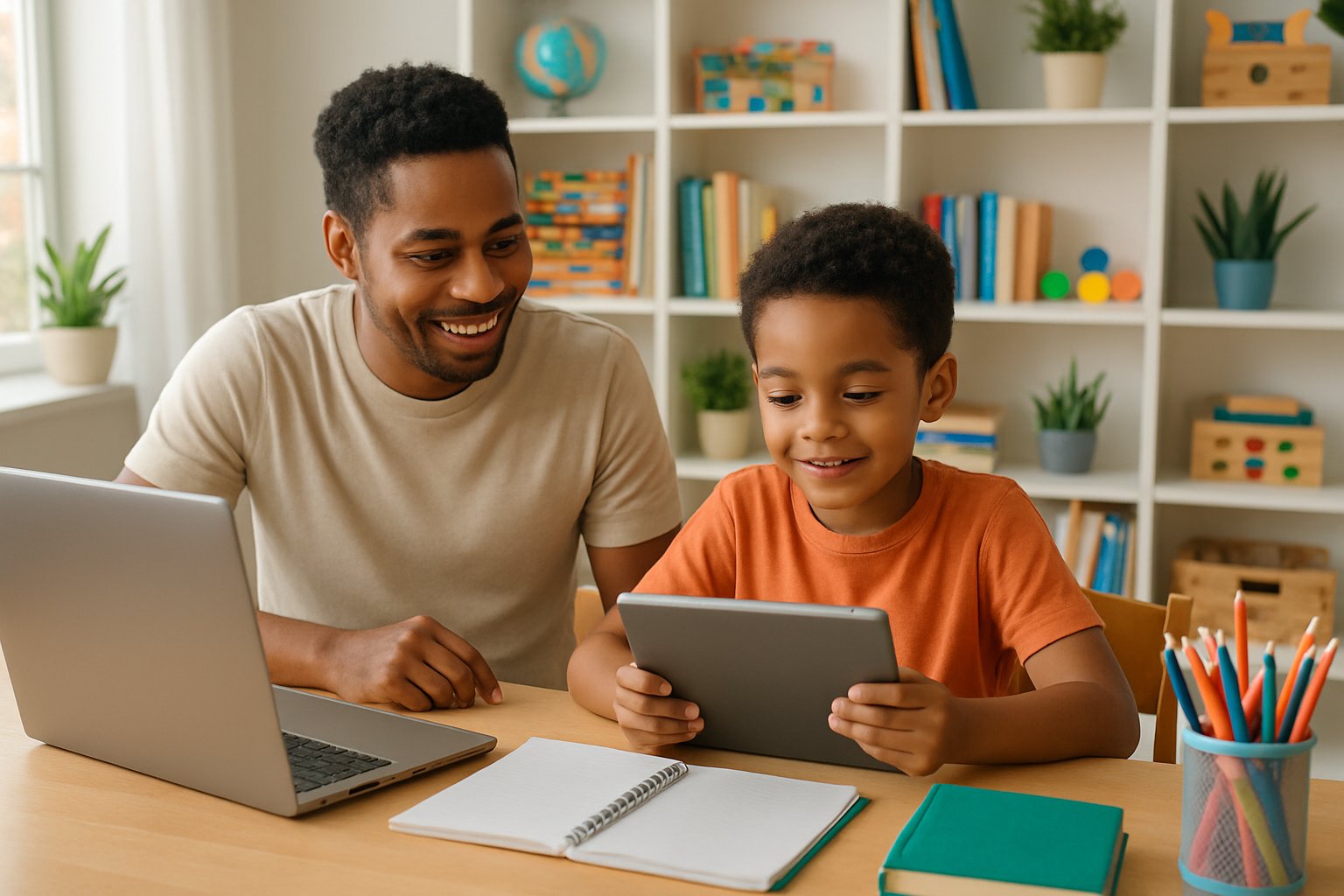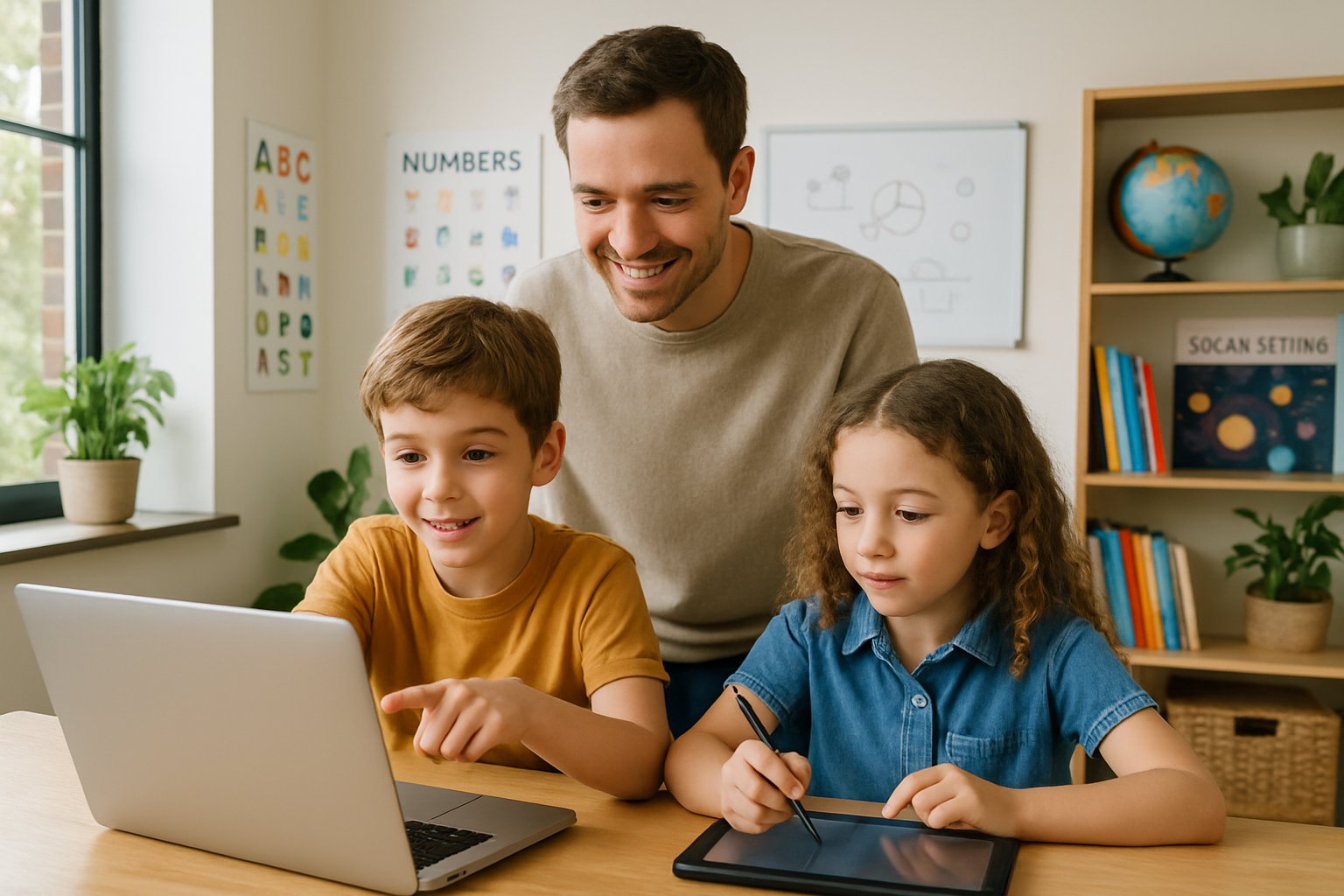Laying the Foundation for Technology in Homeschooling

Technology in homeschooling offers many benefits like interactive learning and access to quality resources, but it also brings challenges that require planning and digital literacy skills. Success depends on understanding both the advantages and potential problems while building essential tech skills from the start.
Benefits of Technology in the Homeschool Classroom
Technology opens doors to learning experiences that traditional methods cannot match. Students can take virtual field trips to museums around the world or explore ancient Rome through interactive websites.
Educational apps and online platforms provide personalized learning paths. These tools adapt to each child’s pace and learning style. A student struggling with math can get extra practice problems, while advanced learners can move ahea
Choosing and Integrating Educational Technology Tools
Success in homeschooling depends on selecting platforms that match each child’s learning style and academic needs. Parents need reliable educational apps, effective learning management systems, and tools that simplify daily lesson delivery.
Selecting the Right Learning Platforms
Parents should evaluate platforms based on their child’s grade level, subject needs, and learning preferences. Khan Academy offers comprehensive lessons across multiple subjects with built-in progress tracking. The platform adapts to different skill levels and provides detailed reports for parents.
Time4Learning delivers complete curriculum packages with automated grading and lesson planning. This platform works well for families who prefer structured, all-in-one solutions. Students can work independently while parents monitor progress through detailed dashboards.
Duolingo excels for language learning with its gamified approach and bite-sized lessons. The app keeps students engaged through streaks, rewards, and interactive exercises. Parents can track daily practice time and skill progression.
Prodigy Math transforms math practice into an adventure game while aligning with curriculum standards. Students solve problems to progress through quests and unlock rewards. Teachers and parents receive detailed analytics on problem areas and strengths.
When choosing platforms, parents should consider subscription costs, offline capabilities, and technical support options. Educational apps and online resources should match the family’s technology comfort level and available devices.
Incorporating Educational Apps and Software
Educational apps work best when integrated into daily routines rather than used as standalone activities. Epic! provides access to thousands of digital books and reading comprehension activities. Children can explore different genres while parents track reading time and book completion.
Canva helps students create presentations, posters, and digital projects with professional-looking templates. The platform teaches design skills while supporting various subject areas. Students can collaborate on projects and share their work easily.
Apps should complement existing curriculum rather than replace core instruction. Parents can use them for skill reinforcement, independent practice, or creative projects. Incorporating educational apps and games keeps children engaged while building digital literacy skills.
Regular evaluation ensures apps continue meeting educational goals. Parents should monitor screen time, assess learning outcomes, and adjust usage based on effectiveness. Some apps offer free trials or basic versions to test compatibility before purchasing.
Utilizing Learning Management Systems
Learning management systems organize assignments, track progress, and streamline communication between parents and children. Google Classroom provides free tools for creating assignments, sharing resources, and managing due dates. Parents can distribute materials digitally and provide feedback on student work.
Seesaw focuses on portfolio creation and family communication. Students document their learning through photos, videos, and voice recordings. Parents receive real-time updates on classroom activities and student progress.
These systems centralize educational resources and reduce paperwork. Parents can store lesson plans, grade assignments, and generate progress reports from one location. Students learn to navigate digital workspaces and submit assignments electronically.
Learning management systems require initial setup time but save effort long-term. Parents should choose systems that match their technical abilities and provide adequate customer support. Cloud-based options allow access from multiple devices and locations.
Balancing Screen Time and Offline Activities

Finding the right balance between digital learning and hands-on activities helps children develop better focus, social skills, and physical health. Effective screen time management involves setting clear guidelines and mixing educational technology with real-world learning experiences.
Strategies for Managing Screen Time
Set Daily Time Limits
Parents should establish specific hours for educational screen use each day. The American Academy of Pediatrics recommends no more than 2 hours of recreational screen time for children over 6.
For homeschooling, educational screen time can be longer but needs breaks every 30-45 minutes.
Create Screen-Free Zones
Designate certain areas of the home as technology-free spaces. The dining room and bedrooms work well for this purpose.
This helps children understand that learning happens in many different ways. Setting clear screen time rules prevents overuse and reduces eye strain.
Use Educational Apps Wisely
Choose high-quality educational programs that encourage active participation rather than passive watching. Interactive math games and coding apps engage students more than videos alone.
Parents should preview all digital content before children use it.
Incorporating Offline Learning Opportunities
Hands-On Science Experiments
Simple experiments using household items teach scientific concepts effectively. Baking bread demonstrates chemistry, while growing plants shows biology in action.
These activities let children touch, smell, and observe real results. Physical activities and creative pursuits support healthy development alongside digital learning.
Reading Physical Books and Audiobooks
Traditional books help develop different reading skills than screens. The physical act of turning pages and holding books creates a different learning experience.
Audiobooks offer another valuable option for learning. Children can listen while doing crafts, taking walks, or resting their eyes from screens.
Art and Creative Projects
Drawing, painting, and building with blocks develop fine motor skills. These activities also encourage creativity and problem-solving without digital devices.
Craft projects can connect to academic subjects like history or science.
Creating a Healthy Tech Routine
Schedule Regular Breaks
Plan 10-15 minute breaks between screen-based lessons. Children can stretch, walk outside, or do simple exercises during these times.
Regular physical activity breaks help prevent the negative effects of sitting too long.
Alternate Screen and Non-Screen Activities
Structure the day so digital lessons alternate with offline activities. For example, follow an online math lesson with hands-on art time.
This pattern keeps children engaged while giving their eyes and minds different types of stimulation.
Track Usage Patterns
| Time Period | Screen Activity | Offline Activity |
|---|---|---|
| 9:00-9:30 AM | Online reading | Physical books |
| 10:00-10:30 AM | Math software | Manipulatives |
| 11:00-11:30 AM | Educational videos | Nature walk |
Monitor how much time children spend on devices each day. Many devices have built-in tracking features that show usage patterns.
Establish Tech-Free Times
Set specific times when no screens are allowed, such as during meals or before bedtime. This helps children develop healthy boundaries with technology.
These quiet times allow for family conversations and reflection on the day’s learning.
Enhancing Engagement and Collaboration Online
Online learning tools can transform how homeschool students connect with peers and explore the world beyond their home classroom. These digital resources create opportunities for real-time interaction, virtual exploration, and streamlined communication that keeps families organized and engaged.
Connecting Through Virtual Classrooms
Virtual classrooms break down the isolation that many homeschool families face. Platforms like Outschool offer live, interactive classes where students can learn alongside peers from around the world.
These online collaboration tools create real community connections. Students can participate in group discussions, work on team projects, and build friendships with other learners who share their interests.
Many virtual classroom platforms include features like:
- Live video chat for face-to-face interaction
- Shared whiteboards for collaborative problem-solving
- Breakout rooms for small group activities
- Screen sharing for presentations and demonstrations
Parents can choose from specialized classes in art, science, foreign languages, or academic subjects. This variety helps students discover new passions while developing social skills in a structured environment.
Exploring Virtual Tours and Cultural Resources
Virtual tours open doors to museums, historical sites, and cultural landmarks worldwide. Google Arts & Culture provides free access to thousands of exhibits that students can explore from home.
These digital field trips make learning more engaging and memorable. Students can walk through ancient Egyptian tombs, visit the Louvre, or explore NASA facilities without leaving their living room.
Popular virtual tour destinations include:
- Smithsonian museums
- National parks and monuments
- International art galleries
- Historical battlefields
- Space centers and observatories
Many virtual experiences offer interactive elements like 360-degree views, audio guides, and educational activities. These features help students engage more deeply with the content than traditional textbook learning allows.
Leveraging Communication and Organization Tools
Communication tools like Skype connect homeschool families with tutors, grandparents, and learning partners across distances. Video calls make it easy to maintain relationships and access expert instruction.
Organization platforms such as Trello help families track assignments, plan field trips, and coordinate schedules. These tools reduce stress and keep everyone informed about daily activities and long-term goals.
Essential organization features include:
- Assignment calendars and due dates
- File storage for completed work
- Progress tracking charts
- Communication threads for family updates
Parents can create shared boards where children check off completed tasks and add notes about their learning experiences. This system builds independence while maintaining clear communication about expectations and achievements.
Personalizing and Monitoring Learning Progress
Technology gives homeschool parents powerful tools to customize education for each child’s unique needs. Digital platforms help track student progress and provide instant feedback to keep learning on track.
Supporting Individual Learning Styles
Every child learns differently, and technology helps create personalized learning paths that match their specific needs. Parents can use digital tools to identify whether their child learns best through visual, auditory, or hands-on methods.
Visual learners benefit from interactive whiteboards and educational videos. Apps like Khan Academy offer colorful graphics and animations that make complex topics easier to understand.
Auditory learners thrive with audiobooks and podcast-style lessons. Text-to-speech software can turn any written material into spoken content.
Kinesthetic learners need hands-on activities and movement. Virtual reality experiences and interactive simulations let them explore concepts through direct engagement.
Online learning platforms allow parents to create custom learning paths based on their child’s interests and abilities. These systems adapt the difficulty level automatically as students progress.
Tracking Achievement and Motivation
Digital tools make it simple to monitor student progress and celebrate achievements. Most educational apps provide detailed reports showing what topics students have mastered and where they need extra help.
Progress tracking features include:
- Completed lesson counts
- Test scores and quiz results
- Time spent on different subjects
- Skill mastery levels
Parents can set up automatic notifications when their child completes assignments or reaches learning milestones. This instant feedback keeps students motivated and engaged.
Many platforms offer digital badges and certificates that students can earn for completing courses or mastering new skills. These rewards create a sense of accomplishment and encourage continued learning.
Technology enables parents to easily monitor progress and receive feedback from educational programs. This data helps them adjust lesson plans and teaching methods to better support their child’s learning journey.
Frequently Asked Questions

Parents often wonder how to set up proper screen time limits and choose the right educational apps for their children. They also need guidance on keeping kids safe online and supporting different ways of learning through technology.
How can technology enhance the learning experience in a homeschool setting?
Technology opens up endless learning resources that weren’t available before. Students can access virtual libraries, interactive apps, and online courses with just a few clicks.
The variety of materials helps match different learning styles. Visual learners can watch educational videos, while hands-on learners can use interactive simulations and games.
Technology makes learning more personalized by letting students learn at their own pace. They can repeat lessons as needed or move ahead when they’re ready.
Virtual field trips let families explore museums, zoos, and historical sites from home. This gives students experiences they might not get otherwise.
What are the best practices for incorporating technology into homeschool lessons?
Parents should mix digital learning with hands-on activities throughout the day. This keeps lessons interesting and helps kids learn in different ways.
Setting clear rules for screen time helps prevent kids from getting distracted. Families can designate specific times for educational technology use.
The “screen-time sandwich” works well for many families. They start with offline activities like reading, move to online tasks, and end with non-tech activities.
Balancing tech-based lessons with active discussions helps kids absorb information better. Parents can talk about what children learned and apply it to real-world examples.
How can parents ensure online safety while using technology in homeschooling?
Parents should check that apps, websites, and platforms are appropriate and education-focused. They can use parental controls to block certain apps or websites when needed.
Regular discussions about safe internet use help kids understand online dangers. Children need to know what information to keep private and how to recognize unsafe situations.
Monitoring what kids access online prevents them from wandering into inappropriate content. Parents can stay nearby during online learning time or check browsing history.
Using trusted educational platforms reduces safety risks. Well-known sites like Khan Academy and educational apps have better security measures.
What are some effective ways to balance screen time and traditional learning in homeschool?
Setting specific time limits for device use helps prevent overuse. Apps like Freedom or Google’s Family Link can manage screen time automatically.
Mixing digital and hands-on activities keeps learning varied. If a child watches a video about ancient Egypt, they can follow up by building a pyramid with blocks.
Digital detox periods are important for avoiding screen fatigue. Families can have screen-free hours or days for outdoor activities and creative play.
Traditional methods like books, worksheets, and discussions should still play a big role. Technology works best when it supports other learning methods rather than replacing them.
How does interactive technology support different learning styles in a homeschool environment?
Visual learners benefit from educational videos, interactive graphics, and virtual tours. These tools make abstract concepts easier to understand through images and animations.
Auditory learners can use podcasts, audiobooks, and music-based learning apps. Text-to-speech features help these students absorb written information better.
Kinesthetic learners enjoy interactive simulations, coding games, and virtual labs. These tools let them manipulate objects and see immediate results from their actions.
Technology allows easy switching between subjects and difficulty levels. This flexibility helps parents adjust lessons to match each child’s learning pace and style.
What are the recommended tools and resources for using technology in homeschool education?
Khan Academy offers free videos and lessons for math, science, and history. The content is easy to follow and works well for different grade levels.
Duolingo makes foreign language learning fun through game-like activities. Scratch teaches basic coding skills through interactive play for beginners.
Google Arts & Culture provides virtual museum tours from famous places like the British Museum. The Smithsonian offers 360-degree tours of natural history exhibits.
Educational apps turn learning into games, making subjects more engaging for kids. E-books and audiobooks give families access to entire libraries on one device.
Learning management systems like Google Classroom help organize lessons and track progress. These tools keep assignments and materials in one easy-to-find place.
Leave a Reply